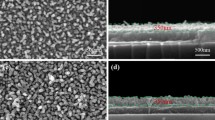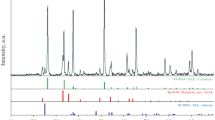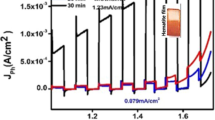Abstract
The preparation of molybdenum-modified hematite electrodes by means of chemical bath deposition and their photoelectrochemical behavior toward water oxidation are reported in this work. The addition of a molybdenum precursor to the bath solution for hematite deposition induces a remarkable change of morphology in the resulting film from (110)-oriented nanorods to polyhedral nanoparticles. Despite the resulting loss of order, by controlling the Mo/Fe molar ratio in the bath solution, a significant improvement of the water oxidation photocurrent is achieved compared to nanorod pristine hematite electrodes. Such a (photo)electrochemical enhancement is mainly explained by an effective surface state passivation in Mo-modified hematite films. FE-SEM, TEM, XRD, and XPS were employed for electrode structural and morphological characterization.

ᅟ








Similar content being viewed by others
References
Gray HB (2009) Powering the planet with solar fuel. Nat Chem 1:7
Liu Q, Asiri AM, Sun X (2014) Hematite nanorods array on carbon cloth as an efficient 3D oxygen evolution anode. Electrochem Commun 49:21–24
Wang G, Ling Y, Wang H, Xihong L, Li Y (2014) Chemically modified nanostructures for photoelectrochemical water splitting. J Photochem Photobiol C Photochem Rev 18:35–51
Bak T, Nowotny J, Rekas M, Sorrell C (2002) Photo-electrochemical hydrogen generation from water using solar energy. Materials-related aspects. Int J Hydrog Energy 27:991–1022
Fujishima A, Honda K (1972) Electrochemical photolysis of water at a semiconductor electrode. Nature 238:37–38
Fàbrega C, Murcia-López S, Monllor-Satoca D, Prades JD, Hernández-Alonso JR, Penelas G, Morante JR, Andreu T (2016) Efficient WO3 photoanodes fabricated by pulsed laser deposition for photoelectrochemical water splitting with high faradaic efficiency. Appl Catal B Environ 189:133–140
Liew SL, Zhang Z, Goh TWG, Subramanian GS, Seng HID, Hor TSA, Luo HK, Chi DZ (2014) Yb-doped WO3 photocatalysts for water oxidation with visible light. Int J Hydrog Energy 39:4291–4298
Cots A, Cibrev D, Bonete P, Gómez R (2016) Hematite nanorod electrodes modified with molybdenum: photoelectrochemical studies. Chem Electro Chem 4:585–593
Liu C, Sun J, Tang J, Yang P (2012) Zn-doped p-type gallium phosphide nanowire photocathodes from a surfactant-free solution synthesis. Nano Lett 12:5407–5411
Bornoz P, Abdi FF, Tilley SD, Dam B, van de Krol R, Graetzel M, Sivula K (2014) A bismuth vanadate-cuprous oxide tandem cell for overall solar water splitting. J Phys Chem C 118:16959–16966
Li Q, Bian J, Zhang N, Ng DHL (2015) Loading Ni(OH)2 on the Ti-doped hematite photoanode for photoelectrochemical water splitting. Electrochim Acta 155:383–390
Oh H, Ryu H, Lee W (2015) Effects of copper precursor concentration on the growth of cupric oxide nanorods for photoelectrode using a modified chemical bath deposition method. J Alloys Compd 620:55–59
Gurudayal D, Jeong D, Jin K, Ahn HY, Boix PP, Abdi FF, Mathews N, Nam KT, Wong LH (2016) Highly active MnO catalysts integrated onto Fe2O3 Nanorods for efficient water splitting. Adv Mater Interfaces 3:1600176
Santamaria M, Terracina S, Konno Y, Habazaki H (2013) Physicochemical characterization and photoelectrochemical analysis of iron oxide films. J Solid State Electrochem 17:3005–3014
Bai Z, Liu F, Liu J, Zhang Y (2017) Enhanced photoelectrochemical performance of n-Si/n-ZnO nanowire arrays using graphene interlayers. J Mater Sci 21:10497–10505
Sivula K, Le Formal F, Grätzel M (2011) Solar water splitting: progress using hematite (α-Fe2O3) photoelectrodes. ChemSusChem 4:432–449
Gurudayal G, Chiam SY, Kumar MH, Bassi PS, Seng HL, Barber J, Wong LH (2014) Improving the efficiency of hematite nanorods for photoelectrochemical water splitting by doping with manganese. ACS Appl Mater Interfaces 6:5852–5859
Deng JJ, Pu AW, Li M, Gao J, Zhang H, Zhong J, Sun XH (2014) Hematite nanostructures for high efficient solar water splitting. IEEE-NANO 2014:75–78
Iordanova N, Dupuis M, Rosso KM (2005) Charge transport in metal oxides: a theoretical study of hematite α-Fe2O3. J Chem Phys 122:144305–144310
Nakau T (1960) Electrical conductivity of α-Fe2O3. J Phys Soc Jpn 15:727
Rosso KM, Smith DMA, Dupuis M (2003) An ab initio model of electron transport in hematite (α-Fe2O3) basal planes. J Chem Phys 118:6455–6466
Cherepy NJ, Liston DB, Lovejoy JA, Deng H, Zhang JZ (1998) Ultrafast studies of photoexcited electron dynamics in γ- and α-Fe2O3 semiconductor nanoparticles. J Phys Chem B 102:770–776
Joly AG, Williams JR, Chambers SA, Xiong G, Hess WP, Laman DM (2006) Carrier dynamics in α-Fe2O3 (0001) thin films and single crystals probed by femtosecond transient absorption and reflectivity. J Appl Phys 99:3–8
Pendlebury SR, Barroso M, Cowan AJ, Sivula K, Tang J, Grätzel M, Klug D, Durrant JR (2011) Dynamics of photogenerated holes in nanocrystalline α-Fe2O3 electrodes for water oxidation probed by transient absorption spectroscopy. Chem Commun (Camb) 47:716–718
Wang G, Ling Y, Wheeler DA, George KEN, Horsley K, Heske C, Zhang JZ, Li Y (2011) Facile synthesis of highly photoactive α-Fe2O3-based films for water oxidation. Nano Lett 11:3503–3509
Brillet J, Cornuz M, Le Formal F, Yum JH, Grätzel M, Sivula K (2010) Examining architectures of photoanode–photovoltaic tandem cells for solar water splitting. J Mater Res 25:17–24
Shen S, Kronawitter CX, Wheeler DA, Guo P, Lindley SA, Jiang J, Zhang JZ, Guo L, Mao SS (2013) Physical and photoelectrochemical characterization of Ti-doped hematite photoanodes prepared by solution growth. J Mater Chem A 1:14498–14506
Itoh K, Bockris JO (1984) Stacked thin-film photoelectrode using iron oxide. J Appl Phys 56:874–876
Shen S, Kronawitter CX, Jiang J, Mao SS, Guo L (2012) Surface tuning for promoted charge transfer in hematite nanorod arrays as water-splitting photoanodes. Nano Res 5:327–336
Shen S, Jiang J, Guo P, Kronawitter CX, Mao SS, Guo L (2012) Effect of Cr doping on the photoelectrochemical performance of hematite nanorod photoanodes. Nano Energy 1:732–741
Xi L, Chiam SY, Mak WF, Tran PD, Barber J, Loo SCJ, Wong LH (2013) A novel strategy for surface treatment on hematite photoanode for efficient water oxidation. Chem Sci 4:164–169
Kalamaras E, Dracopoulos V, Sygelleou L, Lianos P (2016) Electrodeposited Ti-doped hematite photoanodes and their employment for photoelectrocatalytic hydrogen production in presence of ethanol. Chem Eng J 295:288–294
Iervolino G, Tantis I, Sygellou L, Vaiano V, Sannino D, Lianos P (2017) Photocurrent increase by metal modification of Fe2O3 photoanodes and its effect on photoelectrocatalytic hydrogen production by degradation of organic substrates. Appl Surf Sci 400:176–183
Chatman S, Pearce CI, Rosso KM (2015) Charge transport at Ti-doped hematite (001)/aqueous interfaces. Chem Mater 27:1665–1673
Ling Y, Wang G, Wheeler DA, Zhang JZ, Li Y (2011) Sn-doped hematite nanostructures for photoelectrochemical water splitting. Nano Lett 11:2119–2125
Wang L, Lee C, Schmuki P (2013) Ti and Sn co-doped anodic α-Fe2O3 films for efficient water splitting. Electrochem Commun 30:21–25
Park S, Kim HJ, Lee WC, Song HJ, Shin SS, Seo SW, Park HK, Lee S, Kim DW, Hong KS (2014) Sn self-doped α-Fe2O3 nanobranch arrays supported on a transparent, conductive SnO2 trunk to improve photoelectrochemical water oxidation. Int J Hydrog Energy 39:16459–16467
Kleiman-Shwarsctein A, Hu YS, Forman AJ, Stucky GD, McFarland EW (2008) Electrodeposition of α-Fe2O3 doped with Mo or Cr as photoanodes for photocatalytic water splitting. J Phys Chem C 112:15900–15907
Miao C, Ji S, Xu G, Liu G, Zhang L, Ye C (2012) Micro-nano-structured Fe2O3:Ti/ZnFe2O4 heterojunction films for water oxidation. ACS Appl Mater Interfaces 4:4428–4433
Cao D, Luo W, Li M, Feng J, Li Z, Zou Z (2013) A transparent Ti4+ doped hematite photoanode protectively grown by a facile hydrothermal method. CrystEngComm 15:2386–2391
Fu Y, Dong CL, Lee WY, Chen J, Guo P, Zhao L, Shen S (2016) Nb-doped hematite nanorods for efficient solar water splitting: electronic structure evolution versus morphology alteration. Chem Nano Mat 2:704–711
Fu Y, Dong CL, Zhou Z, Lee WY, Chen J, Guo P, Zhao L, Shen S (2016) Solution growth of Ta-doped hematite nanorods for efficient photoelectrochemical water splitting: a tradeoff between electronic structure and nanostructure evolution. Phys Chem Chem Phys 18:3846–3853
Pan H, Meng X, Cai J, Li S, Qin G (2015) 4D transition-metal doped hematite for enhancing photoelectrochemical activity: theoretical prediction and experimental confirmation. RSC Adv 5:19353–19361
Beermann N, Vayssieres L, Lindquist SE, Hagfeldt A (2000) Photoelectrochemical studies of oriented nanorod thin films of hematite. J Electrochem Soc 147:2456–2461
Gota S, Guiot E, Henriot M, Gautier-Soyer M (1999) Atomic-oxygen-assisted MBE growth of α-Fe2O3 on α-Al2O3(0001): metastable FeO(111)-like phase at subnanometer thicknesses. Phys Rev B 60:14387–14395
Chowdari BVR, Tan KL, Chia WT, Gopalakrishnan R (1990) X-ray photoelectron spectroscopic studies of molybdenum phosphate glassy system. J Non-Cryst Solids 119:95–102
Anwar M, Hogarth CA, Bulpett R (1989) Effect of substrate temperature and film thickness on the surface structure of some thin amorphous films of MoO3 studied by X-ray photoelectron spectroscopy (ESCA). J Mater Sci 24:3087–3090
Björkstén U, Moser J, Grätzel M (1994) Photoelectrochemical studies on nanocrystalline hematite films. Chem Mater 6:858–863
Formal F Le, Sivula K, Grätzel M (2012) The transient photocurrent and photovoltage behavior of a hematite photoanode under working conditions and the influence of surface treatments. J Phys Chem C 116:26707–26720
Brookes C, Wells PP, Cibin G, Dimitratos N, Jones W, Morgan DJ, Bowker M (2014) Molybdenum oxide on Fe2O3 core–shell catalysts: probing the nature of the structural motifs responsible for methanol oxidation catalysis. ACS Catal 4:243–250
Acknowledgements
This work was supported by the MINECO of Spain (project MAT2015-71727-R FONDOS FEDER). A. C. wants to thank the University of Alicante for a predoctoral grant. D. C. is also grateful to MINECO for the award of an FPI grant.
Author information
Authors and Affiliations
Corresponding author
Rights and permissions
About this article
Cite this article
Cots, A., Cibrev, D., Bonete, P. et al. Photoelectrochemical behavior of molybdenum-modified nanoparticulate hematite electrodes. J Solid State Electrochem 22, 149–156 (2018). https://doi.org/10.1007/s10008-017-3729-6
Received:
Revised:
Accepted:
Published:
Issue Date:
DOI: https://doi.org/10.1007/s10008-017-3729-6




